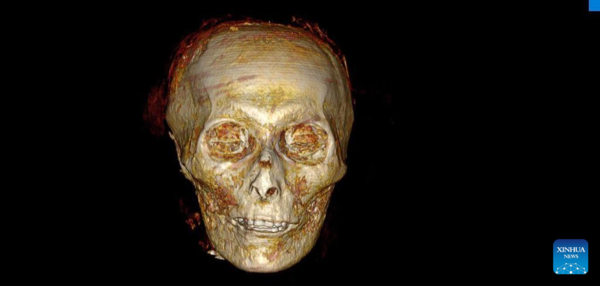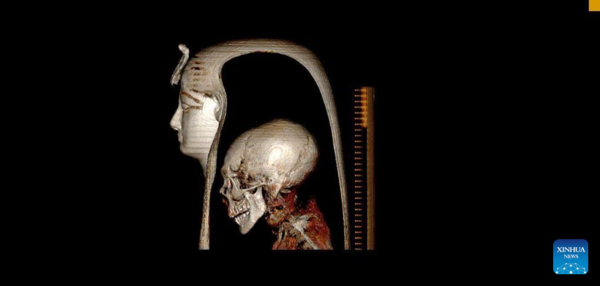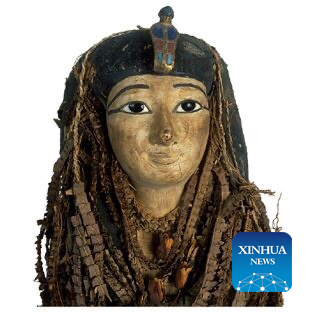Mummy of Egyptian pharaoh Amenhotep I digitally unwrapped
Source: Xinhua | 2021-12-29 | Editor:Lexi

This image provided by Egyptian Ministry of Tourism and Antiquities shows the head of Egyptian Pharaoh Amenhotep I. Egyptian researchers have "digitally unwrapped" the mummy of King Amenhotep I for the first time, revealing many secrets about the pharaoh who ruled Egypt from 1525 to 1504 BC, a renowned Egyptologist said on Tuesday. Researchers used advanced x-ray technology, computed tomography (CT) scanning and advanced computer software programs to digitally remove the wrappings on the mummy of King Amenhotep I in a safe, non-invasive method without touching the mummy, Zahi Hawass, also the former Egyptian minister of state for antiquities affairs, said in a statement. (Egyptian Ministry of Tourism and Antiquities/Handout via Xinhua)
Egyptian researchers have "digitally unwrapped" the mummy of King Amenhotep I for the first time, revealing many secrets about the pharaoh who ruled Egypt from 1525 to 1504 BC, a renowned Egyptologist said on Tuesday.
Researchers used advanced x-ray technology, computed tomography (CT) scanning and advanced computer software programs to digitally remove the wrappings on the mummy of King Amenhotep I in a safe, non-invasive method without touching the mummy, Zahi Hawass, also the former Egyptian minister of state for antiquities affairs, said in a statement.
The research team, which included Sahar Saleem, professor of radiology at Faculty of Medicine of Cairo University and experts in antiquities radiology, revealed for the first time "the face of King Amenhotep I, his age, health condition, as well as many secrets about the mummy's unique mummification and reburial," Hawass said.
Digital analysis showed Amenhotep I's face resembles his father Ahmose I. The king was believed to be in good health when he died at the age of 35, since no disease or injury to the mummy appeared to indicate the cause of his death.
Unlike most of the rulers of the modern kingdoms, such as Tutankhamun and Ramses II whose brains were removed and embalming materials and resins were deposited inside the skull, the brain of King Amenhotep I was not removed during the mummification process, the statement added.
The mummy of Amenhotep I was found in 1881 in the Royal cache at Deir-el Bahri in Luxor, where the priests of the 21st dynasty reburied and hid the mummies of many previous kings and queens to protect them from the recurrent tomb theft.
It is the only royal mummy that has not been unwrapped in the modern era in order to preserve the unique beauty of it, which was covered with a funerary mask and garlands of colorful flowers.
King Amenhotep I was the son of King Ahmose I, who was conqueror of the Hyksos and founder of the New Kingdom of Ancient Egyptian Civilization.

This image provided by Egyptian Ministry of Tourism and Antiquities shows the head of Egyptian Pharaoh Amenhotep I and the funerary mask. Egyptian researchers have "digitally unwrapped" the mummy of King Amenhotep I for the first time, revealing many secrets about the pharaoh who ruled Egypt from 1525 to 1504 BC, a renowned Egyptologist said on Tuesday. Researchers used advanced x-ray technology, computed tomography (CT) scanning and advanced computer software programs to digitally remove the wrappings on the mummy of King Amenhotep I in a safe, non-invasive method without touching the mummy, Zahi Hawass, also the former Egyptian minister of state for antiquities affairs, said in a statement. (Egyptian Ministry of Tourism and Antiquities/Handout via Xinhua)

This image provided by Egyptian Ministry of Tourism and Antiquities shows the funerary mask of Egyptian Pharaoh Amenhotep I. Egyptian researchers have "digitally unwrapped" the mummy of King Amenhotep I for the first time, revealing many secrets about the pharaoh who ruled Egypt from 1525 to 1504 BC, a renowned Egyptologist said on Tuesday. Researchers used advanced x-ray technology, computed tomography (CT) scanning and advanced computer software programs to digitally remove the wrappings on the mummy of King Amenhotep I in a safe, non-invasive method without touching the mummy, Zahi Hawass, also the former Egyptian minister of state for antiquities affairs, said in a statement. (Egyptian Ministry of Tourism and Antiquities/Handout via Xinhua)
You May Like
-
Chinese thriller "Fireflies in the Sun" continues leading do...
Domestic thriller film "Fireflies in the Sun" stayed atop the Chinese mainland box office chart on Tuesday.
InKunming 2021-12-29 -
Foreign films join race for China's top movie awards
The China Golden Rooster and Hundred Flowers Film Festival kicked off on Tuesday in the city of Xiamen, east China's Fujian Province, with foreign films joining...
InKunming 2021-12-29 -
Chinese drama Song of Glory wins global glory at Emmy
Chinese costume drama Song of Glory recently won the best telenovela award at the 49th International Emmy Awards.
InKunming 2021-12-28 -
China's 'lion dance' animation comedy lauded despite tepid e...
Despite moderate box office gains since its opening on Dec 17, Chinese animation comedy "I Am What I Am" continues to grab headlines and receive wide applause.
InKunming 2021-12-28 -
China's First Mermaid Performance Contest in Sanya
A contestant participates in the final of China's First Mermaid Performance Contest in Sanya, south China's Hainan Province, Dec. 22, 2021.
InKunming 2021-12-28 -
1,700 black-necked cranes wintering in snowy Dashanbao form ...
On Dec 26, a cold wave hit Dashanbao Nature Reverse of black-necked cranes in Yunnan’s Zhaotong.
InKunming 2021-12-28 -
Snow view at Lushan Mountain scenic spot, E China
Aerial photo shows the view of Lushan Mountain scenic spot after a snowfall in Jiujiang City, east China's Jiangxi Province.
InKunming 2021-12-27 -
Cultural China: The promise of honesty
Honesty has always been a traditional virtue in China. Despite the passage of time, honesty has been passed down as a mainstream value and embodied in countless...
InKunming 2021-12-27 -
Archaeologists identify ancient royal tomb in China's Jiangx...
An ancient tomb in east China's Jiangxi Province has been identified as belonging to the royals of the State of Yue in the Warring States Period (475-221 BC), l...
InKunming 2021-12-27 -
China's red tourism gathers steam in 2021: report
Red tourism, which refers to visiting historical sites with a modern revolutionary legacy, has become an increasingly popular choice for travelers in 2021, data...
InKunming 2021-12-27







